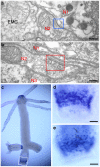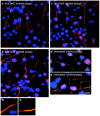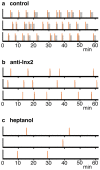Innexin gap junctions in nerve cells coordinate spontaneous contractile behavior in Hydra polyps
- PMID: 24394722
- PMCID: PMC3882753
- DOI: 10.1038/srep03573
Innexin gap junctions in nerve cells coordinate spontaneous contractile behavior in Hydra polyps
Erratum in
- Sci Rep. 2014;4:4009
Abstract
Nerve cells and spontaneous coordinated behavior first appeared near the base of animal evolution in the common ancestor of cnidarians and bilaterians. Experiments on the cnidarian Hydra have demonstrated that nerve cells are essential for this behavior, although nerve cells in Hydra are organized in a diffuse network and do not form ganglia. Here we show that the gap junction protein innexin-2 is expressed in a small group of nerve cells in the lower body column of Hydra and that an anti-innexin-2 antibody binds to gap junctions in the same region. Treatment of live animals with innexin-2 antibody eliminates gap junction staining and reduces spontaneous body column contractions. We conclude that a small subset of nerve cells, connected by gap junctions and capable of synchronous firing, act as a pacemaker to coordinate the contraction of the body column in the absence of ganglia.
Figures





References
-
- Anderson P. A. V. Evolution of the first nervous systems. (Plenum Press, 1990).
-
- Galliot B. & Quiquand M. A two-step process in the emergence of neurogenesis. Eur. J. Neurosci. 34, 847–862 (2011). - PubMed
-
- Mackie G. O. The Elementary Nervous System Revisited. Am. Zool. 30, 907–920 (1990).
-
- Campbell R. D., Josephson R. K., Schwab W. E. & Rushforth N. B. Excitability of nerve-free hydra. Nature 262, 388–390 (1976). - PubMed
-
- Marder E. Electrical synapses: beyond speed and synchrony to computation. Curr. Biol. 8, R795–797 (1998). - PubMed
Publication types
MeSH terms
Substances
LinkOut - more resources
Full Text Sources
Other Literature Sources
Miscellaneous

